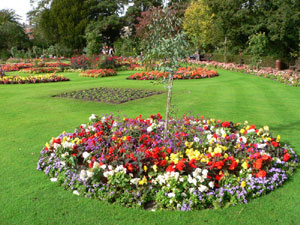
Abbey Gardens in 2005 |
The Menagerie in
the Abbey Gardens
at
Bury St Edmunds
by David Albon
|
1835
|
In her paper “Bury St Edmunds First Botanic Garden” Dr Pat Murrell states that: “In 1835 Nathanial Hodson (the proprietor) added an attraction which still remains a popular feature with visitors to what is in effect the long term result, a legacy of his efforts – that is today’s Abbey Gardens – and that attraction was living animals, particularly water fowl.
The then curator Mr. H. Turner itemised these as:
-
Swan two pairs;
- spoonbill a pair;
- the common heron a pair;
- Canada goose a pair;
- Muscovy duck a pair;
- hook billed duck a pair;
- wigeon a pair;
- pintailed duck a pair;
- a golden-eyed diver;
- a stork;
- pheasant two pairs;
- silver pheasant three individuals;
- golden pheasant two individuals;
- Spanish rabbit;
- lobbed ear rabbit a pair;
- a guinea pig or spotted cavy a pair.”
|
1945
|
By the post Second World War period only a small freestanding aviary for Border canaries remained and this was subsequently extended to provide a separate area for budgerigars, then becoming extremely popular.
|
1950
|
In about 1950 a pair of peacocks was presented to the Borough Council and a large freestanding aviary was built on the area which is now lawn and trees in front of the existing aviary. This also contained golden pheasants and various pigeon breeds, but mainly the Nun variety. The peacocks were later at liberty in this area, calling across the town from the top of the Abbey Wall.
|
1965
|
In about the mid 1960s this aviary was replaced by the present layout against the Abbey Wall. In addition to the peacocks, pigeons, and golden and silver pheasants, the first sheltered enclosure was for a pair of Rhesus macaque monkeys presented by Wells Pet Shop in Short Brackland. The monkeys had until then lived in a cage by the shop doorway, but had become a nuisance to customers by reaching into pockets and bags. (Wells also had an agricultural merchants at 96 Risbygate Street, in the property until recently occupied by the Gun Shop). Wells also gave the menagerie a pair of Java Sparrows which were placed with the canaries, and a blue and gold macaw. This bird may just have been on loan for a specific period.
It is likely that this pair of rhesus macaque monkeys was removed because of the habits of the male and replaced with a pair of green macaque monkeys.
|
1974
|
These green macaque monkeys were certainly present when the new Parks Superintendent, Peter Tunnah, took up his post in 1974.
|
1979
|
In the late 1970s the male macaque, a fine specimen, was given to a Northampton zoological agent to escape the aggressive nature of the female.
|
1985
|
The remaining female monkey did not age gracefully before her death in the mid 1980s. Mr Tunnah reports that she was only friendly when ill!
At this time, the pigeons were replaced with more exotic birds such as species of starling and parrot, cockatiels, lovebirds and small duck such as Chilean Teal. Reeves and Elliot’s pheasants were introduced and also varieties of domestic fowl such as Hamburghs and Sebrights.
It is interesting to note that in the 1950s the main variety of duck on the River Lark was the Muscovy, mentioned in the original Turner list, with very few mallard. A pair of Chinese geese was given at this time, the progeny of which remained on the river for many years.
|
2013
|
The menagerie in the Abbey Gardens was established just a few years after the opening of London Zoo, and it is a nice historical continuity that it still remains and attracts so much interest and attention. Bury's menagerie, small as it is, remains one of the oldest zoological collections in the country.
Prepared for the St Edmundsbury website
by David Albon, January, 2013
| | | | | | | |
|

